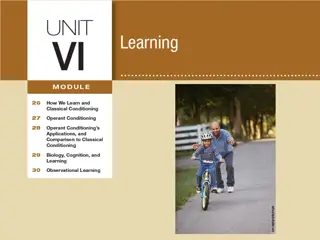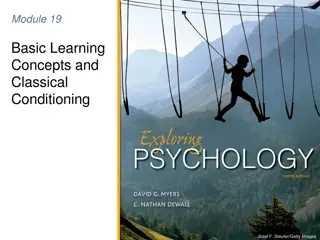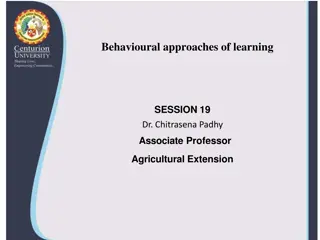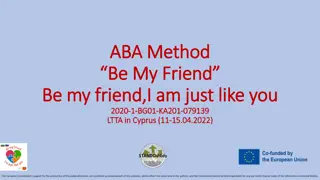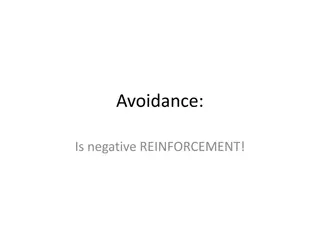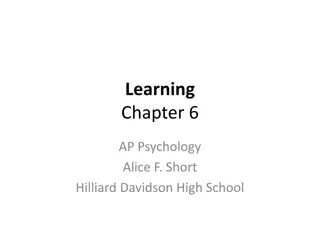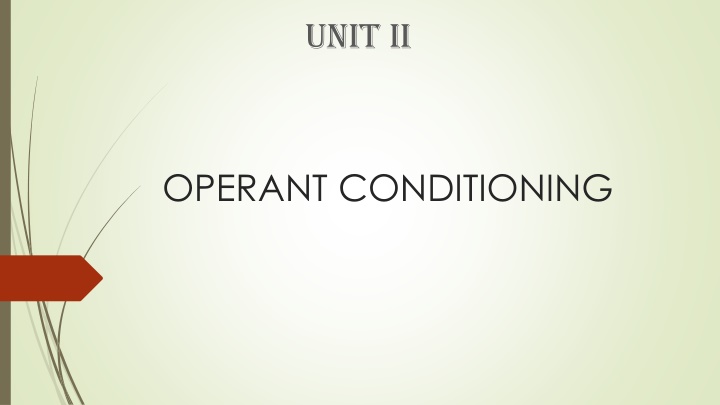
Operant Conditioning and Its Applications
Operant conditioning, pioneered by B.F. Skinner, is a behavioral learning process where consequences of actions influence the likelihood of those actions being repeated. This theory, based on the Law of Effect by Edward Thorndike, explores how positive and negative reinforcements shape behavior. Through experiments like the Skinner Box, where rats learned to press a lever for food, we see how operant responses are modified by consequences, leading to either increased or decreased probability of certain behaviors. Reinforcements play a crucial role in this process, with both positive and negative reinforcements affecting future behavior.
Download Presentation

Please find below an Image/Link to download the presentation.
The content on the website is provided AS IS for your information and personal use only. It may not be sold, licensed, or shared on other websites without obtaining consent from the author. If you encounter any issues during the download, it is possible that the publisher has removed the file from their server.
You are allowed to download the files provided on this website for personal or commercial use, subject to the condition that they are used lawfully. All files are the property of their respective owners.
The content on the website is provided AS IS for your information and personal use only. It may not be sold, licensed, or shared on other websites without obtaining consent from the author.
E N D
Presentation Transcript
Unit II OPERANT CONDITIONING
Operant Conditioning Operant conditioning is a procedure by which a change in the consequences of a response will affect the rate at which the response occurs. The term was coined by B. F. Skinner and theory proposed by him Skinner believed that behavior is motivated by the consequences we receive for the behavior : the reinforcements and punishments.
Law of effect (Edward Thorndike) According to this law, behaviors that are followed by the consequences that are satisfying to an organism are more likely to be repeated, and behaviors that are unpleasant are less likely to be repeated. For example, in employment, one of the reasons (often the main reason) people show up for work is because they get paid to do so. If they stop getting paid, they will likely to stop showing up. Working with Thorndike s law of effect as foundation, Skinner began conducting scientific experiments on animals (mainly rats and pigeons) to determine how organisms learn through operant conditioning. (Skinner,1938)
The Skinner Box (Operant Chamber) As the first step of the experiment, Skinner placed a hungry rat inside the Skinner box. The rat was initially inactive inside the box, but gradually as it began to adapt to the environment of the box, it began to explore around because of the hunger. Eventually, the rat discovered a lever, upon pressing which; food was released inside the box. After it filled its hunger, it started exploring the box again, and after a while it pressed the lever for the second time as it grew hungry again. This phenomena continued for the third, fourth and fifth time, and after awhile the hungry rat immediately pressed the lever once placed in the box. Then the conditioning was done. Here, the action of pressing the lever is an operant response/behavior, and the food released inside the chamber is the reward.
Operant Response An operant response is a behavior that is modifiable by its consequences. When behavior is modified by its consequences, the probability of that behavior occurring again may either increase (in the case of reinforcement) or decrease (in the case of punishment).
Reinforcements An environmental event that is the consequence of an operant response and that makes that response more likely to occur again in known as a reinforcement or reinforcer. There are two types of reinforcements 1. Positive reinforcements 2. Negative reinforcements Positive reinforcements are the stimulus or event which when follows a response, increases the likelihood of the response to be made again. Negative reinforcements are the stimulus or events which when ceased or terminated, increases the likelihood of the response to occur again.
Punishment Punishment , responses from the environment that decreases the likelihood of a behavior being repeated. Punishment weakens Behavior. Punishment is defined as the opposite of reinforcement since it is designed to weaken or eliminate a response rather increase it
The effectiveness of punishment depends upon a number of factors:- 1. To guide behavior mild punishments are the most effective in the long run. 2. When mild punishment is used to suppress one behavior and at the same time positive reinforcement is used to make another behavior more likely to occur, is a powerful way of using punishment to mold behavior.
Shaping of Behavior : Successive Approximation In shaping, behaviors are broken down into many small, achievable steps and instead of rewarding the target behavior, we reward successive approximation of the target behavior. For example, Skinner trained a pigeon in a very short time to peck at a specific spot it it s cage. The probability that the pigeon would peck at that exact spot on its own was very low. So first, the pigeon was reinforced with food when it merely turned toward the designated spot. Then reinforcement was withheld until the pigeon made some movement, however slight, toward the spot. Next, reinforcement was given only for the movements that brought the pigeon closer to the spot. After that, the pigeon was reinforced only when it thrust its head towards the spot. Finally the pigeon was reinforced only when it s beak touched the spot. Although this sounds like a time consuming process but Skinner conditioned the pigeon in less than 3 minutes.
Extinction Extinction is the process of eliminating a behavior by withholding reinforcement. If the reinforcement no longer follow the response, the tendency for it to occur will decrease. If the extinction procedure continues long enough, the likelihood of a response will decrease to about it s level before it was reinforced.
Schedules of Positive Reinforcements When an organism receives a reinforcer each time it displays a behavior, it is called Continuous Reinforcement. This reinforcement schedule is the quickest way to teach someone a behavior, and it is especially effective in training a new behavior. The timing to present the reinforcer is very important. The most successful is when reinforcer is present immediately after the behavior, so that the subject can make an association between the target behavior and the consequence. Once a behavior is trained, researchers and trainers often turn to another type of reinforcement schedule partial reinforcement.
In partial reinforcement (intermittent reinforcement), the person or animal does not get reinforced every time they perform the desired behavior. Fixed Number of responses between reinforcements or the amount of time between reinforcements which are set and unchanging. Number of responses or amount of time between reinforcements, which varies or changes. The schedule is based on the time between reinforcements. The schedule is based on the number of responses between reinforcements. Variable Interval Ratio
Stimulus Generalization Generalization occurs when an organism makes the same response to a different stimuli. If the stimulus situation is changed, the response still occurs but less readily then it did in the original stimulus situation. Furthermore, the tendency to respond depends upon the degree of similarity between the original training situation and the changed one. For example, Pigeons were shaped and trained with the reinforcement to peck a key in an operant chamber. During the original learning a moderately bright light illuminated the key. After the pecking response to this stimulus had been well learned and the rate of response was high and steady, the animals were tested with six other intensities on the key. These test stimuli were spaced steps of equal intensity from low to high. Results showed that the pigeons had a tendency to respond to these new stimuli and the degree to which they responded depended on the size of the brightness difference between the original and test stimuli.
Stimulus Discrimination Discrimination is the process of learning to make one response to one stimulus and another response or no response to another stimulus. It is also called stimulus control of behavior. In operant conditioning experiment, discrimination is achieved simply by reinforcing a particular response to one stimulus and not reinforcing which amounts to extinguishing the same response to another stimulus. For example, the pigeon in this experiment were positively reinforced for key peck responses only when the translucent key was illuminated by a light that appeared yellow-green to human observers. During the intervals of yellow-green illumination, the pigeons received contingent positive reinforcement for pecking the key. If another light, a red one, illuminated the key, the pigeon received no reinforcement. Consequently, the birds learned to peck during the yellow-green, but not during the red periods. After such a discrimination has been learned, the change in behavior when the stimulus are shifted is dramatic.
Avoidance Learning Avoidance learning is the process by which an individual learns a behavior or response to avoid a stressful or unpleasant situation. The behavior is to avoid, or to remove oneself from the situation. In a common laboratory experiment conducted to demonstrate avoidance learning, a rat is placed in n confined space with an electrified floor. A warning signal is given, followed by an electric current passing through the floor. To avoid being shocked, the rat must find an escape, such as a pole to climb or a barrier to jump over on to a non- electric floor. At first, the rat responds only when the shock begins, but as the pattern is repeated, the rat learns to avoid the shock by responding to the warning signal.







